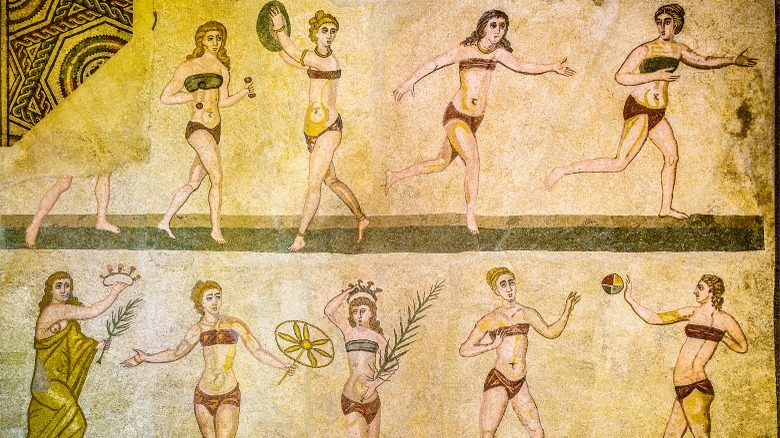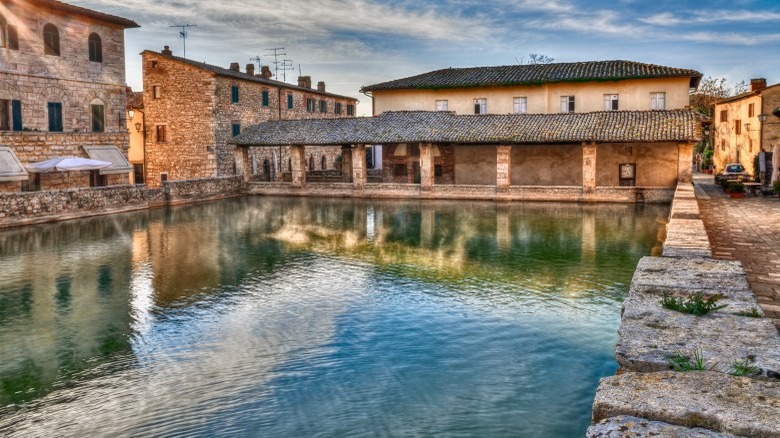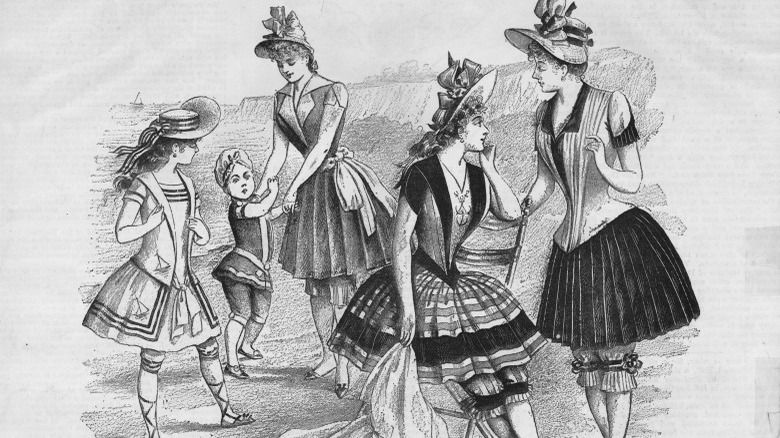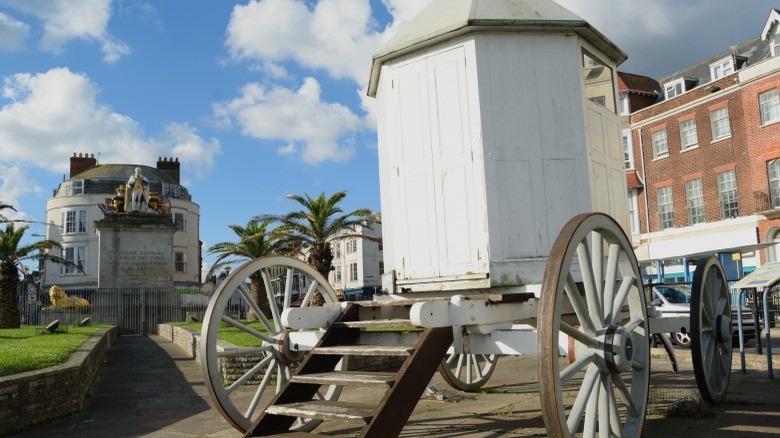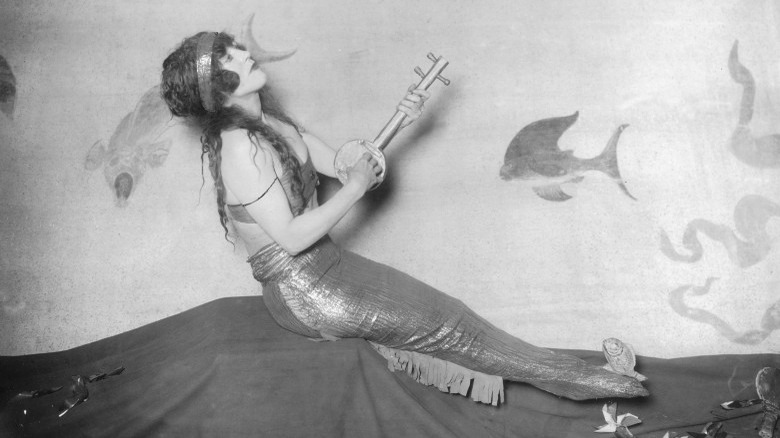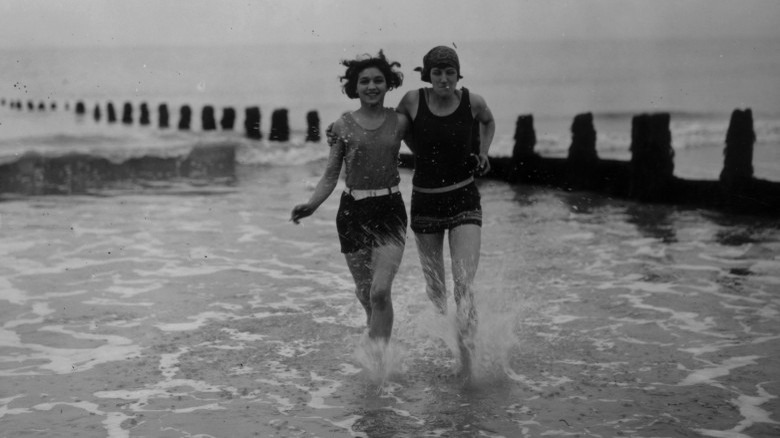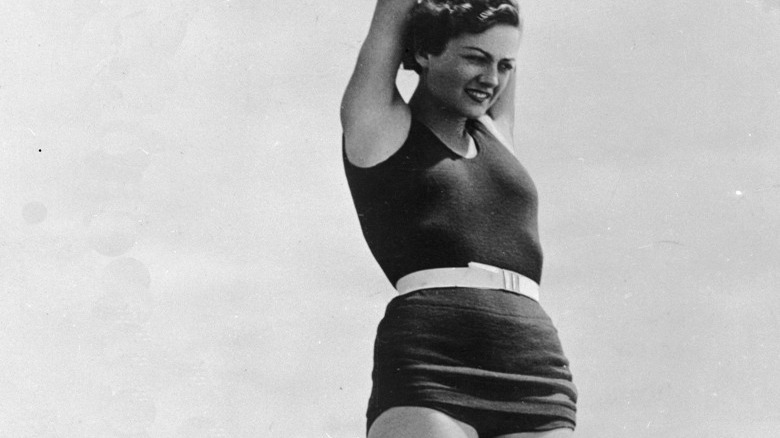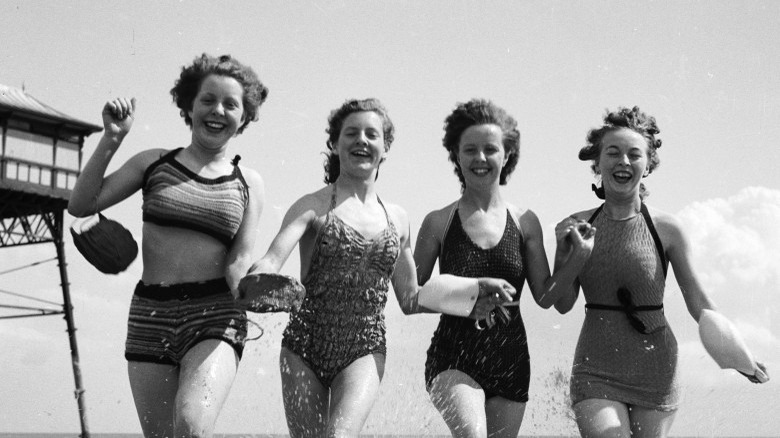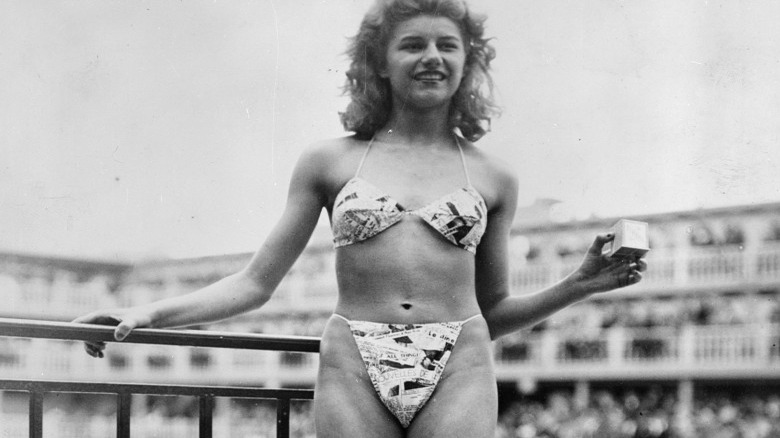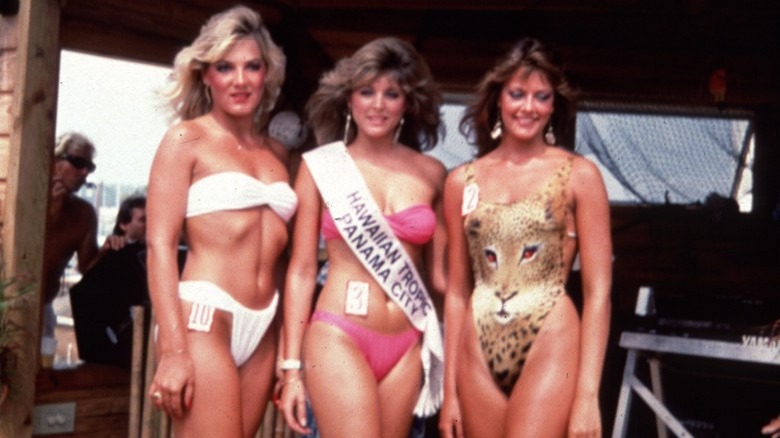How Swimsuit Styles Have Changed Over The Years
We may receive a commission on purchases made from links.
Swimsuit styles run such a gamut that while you're usually excited to get to the beach and take in the good weather at the start of summer, the prospect of picking out a swimsuit is far less exciting.
There are so many options — and revealing so much of your body after the winter may not be your favorite thing. But when you look back the history of swimwear, we should consider ourselves lucky. Here's a glimpse into how swimsuits have drastically changed over time.
Ancient Rome (753 BC - 476 AD)
Many of us might think that the farther back you go in history, the more covered up women were required to be. But that isn't exactly the case. As printed in an article for the University of Pennsylvania Museum, the Villa Romana del Casale houses frescos that show women wearing what looks like two-piece swimsuits.
The museum states that scholars agree that the women in the painting are competing in an athletic competition. Female sports contests were fairly common among the elite and were a great show of the host's status. Often called "The Bikini Girls," the fresco shows that women were allowed lesser coverage, at least for the sake of sport.
Late 1600s
In the Western world, bathing was a luxury. According to Salon, it wasn't godly to indulge in luxuries, so monks and priests would hardly bathe at all, so that they could be closer to God — and farther away from people with a sense of smell. Salon noted an instance where the 14th century King of France asked a doctor about what was causing the black plague. The doctor told him that people were bathing in hot water, which opened their pores and opened them up to the disease. If bathing meant the plague, a leisurely trip to the old swimming hole was really out of the question.
But by the late 1600s people's aquatic fears started to subside, especially when Queen Mary and Queen Anne sang the praises of the natural hot springs of Bath, England, according to traveller and writer Rick Steeves. Salon reported that bathing in hot springs, or the sea, was a prescribed medical procedure, not something to do on vacation. So, if a woman had to go to a bath, she had to wear a stiff, shapeless garment. Not exactly the swimsuit style choice of today.
The Smithsonian published the travel notes of Englishwoman Celia Fiennes, on bathing wear in 1687, "The [ladies] go into the bath with garments made of a fine yellow canvas, which is stiff and made large with great sleeves like a parson's gown. The water fills it up so that it is borne off that your shape is not seen, it does not cling close as other [linings], which [looks] sadly in the poorer sort that go in their own [lining]."
Victorian era (1837-1901)
By the Victorian age, water was no longer considered dangerous, so trips to the seaside became more popular. Since this was a period in which women were charged with upholding "a nation's moral wealth," ladies' bathing clothes were, not surprisingly, incredibly bulky.
In the book We Did What?, editor Timothy B. Jay details the proper Victorian "bathing costume" which consisted of a high necked dress with 3/4 length sleeves and a knee length skirt. But that wasn't all. Beneath that, women had to wear long bloomers and black stockings, so none of their legs could be seen. All of this came in a heavy flannel, that would easily weigh you down in the water.
This swimsuit alone still wasn't modest enough for some Victorians. In The Englishwoman's Domestic Magazine (via the book How to be a Victorian), an article was penned in 1868 about a new modern product: swimming corsets! Described as being "very small, and made with whalebones, but no steel, on purpose to wear when bathing." Swimming in a long, heavy skirt, tights, and a corset sounds like the worst beach trip since Castaway.
Bathing machines (1837-1901)
Victorians were so worried about any errant man viewing a woman's body at the beach, they invented a machine to keep the bathing beauties out of sight. Yes, even though the ladies were already wearing full dresses, bloomers, and stockings, the swimwear was still considered too risque.
According to The Independent, a bathing machine was a device that looked a bit like a small changing room on wheels. The woman would get inside, change into her bathing costume, then the contraption would be pulled into the surf by horses, where she would climb down a little latter and enjoy the water. This incredibly complicated process insured that bare ankles, or ladies without a bathing corset, would not be seen by lascivious men.
Also, the beaches were legally separated by sex at the time, so this was to make sure no man on the male beach with binoculars — or really good eyesight — could catch a peek. According to The Independent, Queen Victoria owned a machine, because she "feared being spotted by sailors peering through telescopes."
Annette Kellerman swimsuit pioneer (1907)
Australian swimmer Annette Kellerman made recreational swimming popular again and held every female swimming record in 1905. Plus, she appeared in vaudeville shows as The Australian Mermaid. When Kellerman showed up at a beach near Boston in 1907, she was arrested for her "scandalous" attire. Her shocking swimsuit was a one-piece with tank top straps and shorts. Today, you'd be the most covered-up girl on the beach wearing it, but 1907 Boston wasn't having it.
The Boston Sunday Globe (via Boston) ran an article about Kellerman in 1953 that included an interview with the record-breaking swimmer. She said the arrest was a misunderstanding "but the judge was quite nice and allowed me to wear the suit if I would wear a full-length cape to the water's edge." The article went on to say, "In a few short years the Annette Kellerman one-piece bathing suit was the accepted female attire for beach and pool, symbol and fact of new freedom for women.”
Let's take a moment and thank Kellerman for saving future generations of women from the hassle of wearing a thick flannel dress to the beach.
1920s
In the age of flappers, all the long bathing gowns, as well as low hemlines, were gone. Swimwear had now evolved into close fitting one-pieces with small skirts or shorts. Jantzen became the top name in swimsuit style and the diving image of the "Jantzen Girl" was splashed across billboards all over the country.
Though these suits looked much more akin to what we wear today, they would have felt very different. Jantzen's website states their first swimsuits were made entirely of wool and that remained the primary material through most of the 1920s. Imagine swimming in a tight fitting sweater. Still, these suits allowed women to move freely and reveal a bit more of their bodies.
1930s
The '30s didn't bring about a big change in the cut of swimwear, but the material changed drastically. Jantzen began to weave Lastex (a form of elastic thread) into their swim suits. According to Carol Alhadeff, Jantzen archivist (via Fashionista) "[It] was considered a miracle yarn because it stretched both ways."
According to the Vintage Fashion Guild, Mabs of Hollywood made Lastex swimsuits for big Hollywood stars like Joan Crawford and Jean Harlow. When Lastex swimwear got the Hollywood seal of approval, knit swimsuits were over and done.
World War II (1941-1945)
The rationing of World War II affected every American, including swimsuit manufacturers. But who would have thought it would take a World War to lead to a woman wearing a two-piece?
In 1943, the government ordered that makers of swimsuits had to reduce their fabric used by ten percent. The best way to do that was to make a two-piece. By showing off a little midriff, you were doing your duty for America. These suits still weren't terribly revealing, featuring very high waisted bottoms with tops that showed minimal cleavage. Still, this was a big step towards women choosing what they wanted to wear to the beach.
Invention of the Bikini (1946)
In France, designers Jacques Heim and Louis Réard wanted to create a piece of clothing that exemplified the country's newfound freedom and happiness after the end of World War II, according to History. So, they came up with the skimpiest swimsuit style to date, the bikini.
Réard took the name from the location of a US atomic test near the Bikini Atoll. And this new look was pretty explosive. According to fashion historian Amber Butchart (via The Telegraph), author of The Fashion of Film, the first bikini was a complete shock. "Indeed, the bikini was so scandalous when it premiered that Réard had difficulties finding a model to wear it, so had to hire the nude dancer Micheline Bernardini."
The article goes on to say that the Vatican declared the bikini "sinful," with many European nations in the '50s attempting to ban the suit. But by the time the '60s rolled around — and Bond girls and cave women were sporting skimpy two-pieces — bikinis became common.
1970s and on
Though bikinis certainly never went out of style, in the '70s, Farrah Fawcett brought back the one-piece with her iconic pin up poster. Most of Sports Illustrated's top picks of the '70s are one-pieces similar in shape to the one Fawcett made famous.
The '80s brought back a slightly skimpier look, and whether it was one-piece, or two, swimsuit styles were definitely cut high on the thigh. Photographer Keith McManus documented the spring breaks between 1982 and 1993 in his book Rites of Passage. The photos (via Messy Nessy Chic) show that small bikinis were in and women weren't afraid of showing off a lot of skin.
In the '90s, string bikinis were still popular, but the tankini became the latest trend. The combination of tank top and swim bottoms brought a lot more coverage to two-piece swimwear.
The 21st century brought about a mix of everything. Cosmopolitan revealed Brazilian-style skimpy bottoms as all the rage in 2014. Though that look had been popular in Brazil for years, and it took Americans a little time to warm up to it, mainstream retailer Victoria's Secret now sells "Itsy" and "Cheeky" bottoms for ladies worldwide. But swimwear styles are up to the wearer! These days, it's easy to find retro high waisted bikinis, athletic one-pieces, and everything in between.

